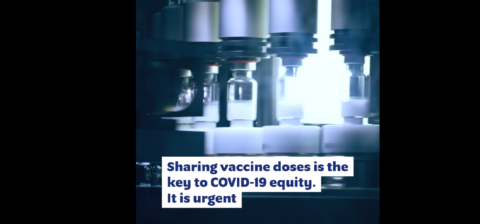Boosting production of COVID-19 vaccines is key to ensuring there are enough doses for all populations most at risk. But manufacturing COVID-19 vaccines at the volumes the world needs is a colossal challenge and scarcity of raw materials and trade barriers could upset estimates that 11 billion doses – enough for the world’s adult population – can be produced by the end of 2021.
To achieve vaccine equity, vaccine manufacturing yields must be optimized and bottlenecks in the supply chain either pre-empted or tackled urgently.
Not Business as Usual
Scaling up manufacturing has been a daunting task, but thanks to steps taken in the first months of the pandemic, production for COVID-19 vaccines has increased from zero to 3 billion doses in the past six months since the first approval of a COVID-19 vaccine.
It has required an unprecedented effort and collaborations across the pharmaceutical and vaccines industries both in developed and developing countries. The good news is that we are now on track to more than double pre-pandemic global capacity for all vaccines and achieve 11 billion doses of COVID-19 vaccines by the end of the year.
But production needs to accelerate and be optimized. At present it can take between 90 to 120 days to manufacture a single batch of COVID-19 vaccine whether mRNA, viral vector or recombinant protein. Companies are working to reduce lead times as much as possible. For example, Pfizer-BioNTech launched ‘Project Light Speed’ to shorten production time of its mRNA vaccine from 110 to 60 days.
Successful Collaborations
From the onset the industry knew it would need to scale up rapidly and vaccine makers quickly began scouring the world to find suitable and trusted partners with proven track records and the “best fit” for assured quality, efficiency and scale of production. Today, there are more than 300 partnerships and collaborations that are working with vaccine makers towards this historic effort.
What has been achieved so far is unprecedented and licensing agreements and technology transfers have been fundamental in scaling up. Efforts to create globally-optimized networks of suppliers and producers are paying off.
We have seen biotechs, pharmaceutical companies, and contract manufacturing organizations (CMOs) from developed and developing countries come together to increase capacity. Vaccine innovators have built ties with hundreds of companies, the best known being theSerum Institute of India, Bharat Biotech, Aspen Pharma and also Biological E. Whether the collaborations involve helping make the vaccine from scratch or contributing to the final stages, such as “fill and finish” the vaccine innovator will help by transferring its know-how and technology, to ensure partners can reach the levels of quality needed, as well as the optimum levels of output.
This sharing of knowledge does take time to get it right. For example, in addition to its existing manufacturing capacities, Johnson & Johnson has entered into multiple agreements to expand manufacturing capability for drug substance, drug product, or packaging, with more than 10 manufacturing partners around the world. One of these partners is Aspen Pharma with whom Johnson & Johnson agreed to transfer its technology last year. Their joint efforts will soon be paying off, with the first vials leaving the manufacturing lines in South Africa in the coming weeks. But sometimes, despite everybody’s best efforts, things go wrong. One of Johnson & Johnson’s partners Emergent BioSolutions in the USA was found not to be fully compliant with safety and effectiveness. This resulted in the FDA stepping in and deciding that 75 million doses need to be thrown away.
Many have heard of the licensing agreement AstraZeneca made with the Serum Institute of India last April, but this is not the only collaboration AstraZeneca is involved with. The company has recently announced a technology transfer agreement with Fiocruz in Brazil, which builds substantially on existing fill and finish to allow active pharmaceutical production.
Since IFPMA announced its 5-step plan to urgently improve vaccine equity on 19th May, the already high number of partnerships has further increased from 286 to 307. New tie-ups include AGC Biologics and BioNTech or Moderna and Samsung Biologics and Thermo Fischer Scientific.
Technology transfers are complex in their nature, including the technology itself. Certain external factors play a key role in determining whether a company wishes to engage in a technology transfer within a region. These factors include a transparent and stable legal and policy framework, an innovation ecosystem backed by intellectual property incentives, high technical and regulatory standards, availability of raw materials and trade barriers, to name a few. In addition, it is crucial that the partner being selected is one that has the capacity and capability to absorb the technology, have the necessary skilled worker and the ability to scale up. A proven track record on safety and quality is undeniably a factor where no compromise should be made.
The basis of any technology transfer arrangement is trust and willingness to work together, and we have seen how transfer of know-how can be greatly accelerated.
Challenges Ahead: Shortages of Critical Supplies and Workforce
Despite the best efforts of all those involved in the scaling up of manufacturing, there are numerous challenges that could thwart vaccine production and the first year estimate of 11 billion doses. Raw materials are in short supply and scarcity of critical input supplies, such as bioreactor bags, single-use assemblies, cell culture media, filters, lipids, vials and stoppers is hampering production. A delay in the supply chain of any one of these components can set back production output by weeks if not months.
It is important to stress that these ingredients are also needed for other routine vaccines, such as hepatitis, measles, shingles and biological medicines used in the treatment of cancer. Greater visibility in the supply chain could help avert these bottlenecks.
Also key to continued production is a skilled workforce. Vaccines are complex biological products, and their production and oversight requires a complicated dance of multiple experts in manufacturing, quality, regulation, engineering, and logistics as well as trainers, lab technicians, maintenance crews, scientists, and many more. Pharmaceutical manufacturing teams are currently stretched, and additional specialized technicians are needed to ensure the smooth running of the myriad of production steps and quality checks. As Moderna experienced when Lonza was unable to start production as soon as had been hoped, due to a lack of skilled technicians needed to set up and run production lines.
The World Trade Organization (WTO) and The World Customs Organization (WCO) also have an important role to play to work with governments to eliminate trade barriers to export and to adopt policies that facilitate and expedite the cross-border supply of key raw materials, essential manufacturing materials and vaccines, along with the prioritized movement of skilled workforce needed for COVID-19 vaccine manufacturing.
Speed up Regulatory Processes
Finally, the pandemic has shown that regulatory systems can collaborate and be more agile, and this can help avoid wasting time and resources. Regulatory approvals for COVID-19 vaccines have been facilitated and accelerated, but there is a need to continue to harmonize regulatory standards across countries and speed up requirements to validate processes, approve new manufacturing sites, and avoid redundant local testing that could reduce the remaining shelf life for a vaccine.
In addition, the emergence of variants requires regulatory authorities to react quickly to approve updated vaccines. Solutions to help expedite these approvals include use of reliance, work-sharing, and recognition processes along with digitalization.
Staying Ahead
Industry continues to carry out research to ensure the wheel of innovation continues. We are hopeful that several new vaccines are likely to come to the market in the next few months. Upon regulatory approvals, Novavax remains on track to reach manufacturing capacity of 100 million doses per month by the end of the third quarter and 150 million doses per month by the fourth quarter of 2021.
However, addressing bottlenecks with practical steps must continue. That’s why our 5-steps plan to urgently address vaccine inequity is important. Manufacturers, governments, and non-governmental organizations must work together to take urgent steps to address vaccine inequity, with immediate action on stepping up responsible dose sharing and maximizing production without compromising quality or safety. We must remain ahead of the virus and collaboration is the only way out of the pandemic.













